Raspberry (Rubus idaeus) Native and Non-Native Varieties
Raspberry (Rubus idaeus)
Parts used: leaf, fruit
Medicinal uses: For their astringent properties, to treat diarrhea and as a gargle for mouth or throat infections, and as an ingredient in teas. Also tones the uterus helping to ease labor in childbirth.
Nutritional information: Raspberries are an excellent source of fiber, manganese, vitamin C, flavonoids, and ellagic acid. They are a very good source of vitamin B2 as well as a good source of other B vitamins, such as folic acid, niacin, pantothenic acid, and vitamin B6 (Murray 312).
Cautions: Some recommend not taking raspberry leaf medicinally during the early stages of pregnancy. Others recommend the use of this tonic plant throughout pregnancy (Chevallier 263, Gladstar, Romm).
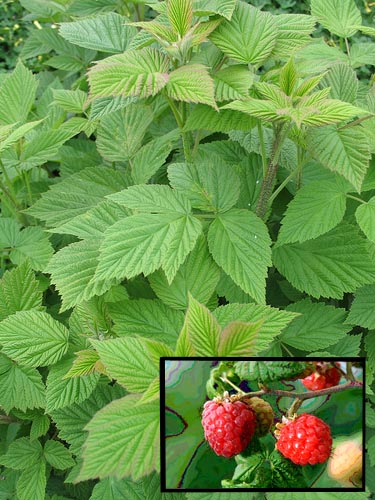
Pacific Northwest Medicinal Plant Guide (Check out all plants growing in Tryon Farm's medicinal garden!)
- Login to post comments



Poppy (Papaver rhoeas) Non-Native
Poppy (Papaver rhoeas)
Parts used: flowers
Medicinal uses: This entry focuses on the uses of the corn or field poppy rather than its more notorious relative the opium poppy (P. somniferum). The flowers are mildly analgesic and sedative and have been used extensively throughout Europe for ailments of children and the elderly. It is used chiefly as a mild pain reliever and as a treatment for irritable coughs, it also reduces nervous over-activity. The herb may also be used for insomnia, nervous irritability, coughs, and asthma (Chevallier 243).
Additional uses: The poppy seeds are often used in culinary applications. The flowers have been used in the past to color wines and medicines (Bremness 263).
Cautions: Use only under professional supervision. All parts of this plant aside from the seeds are potentially toxic if eaten (Chevallier 243).

Pacific Northwest Medicinal Plant Guide (Check out all plants growing in Tryon Farm's medicinal garden!)
- Login to post comments



Plum (Prunus domestica) Native
Plum (Prunus domestica)
Parts used: fruit
Nutritional information: plums are a very good source of vitamin C. They are also a good source of vitamins B1, B2, and B6, phenolic compounds, and dietary fiber (Murray 306).
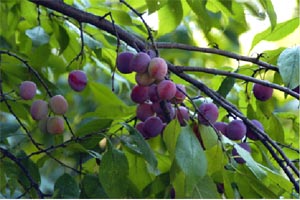
Pacific Northwest Medicinal Plant Guide (Check out all plants growing in Tryon Farm's medicinal garden!)
- Login to post comments



Plantain, common (Plantago major) and Ribwort plantain (Plantago lanceolata) Non-Native
Plantain, common (Plantago major) and Ribwort plantain (Plantago lanceolata)
Parts used: leaves
Medicinal uses: Quickly staunches blood flow and encourages the repair of damaged tissue. It can be used to treat bruises and broken bones. An ointment or lotion can be used to treat hemorrhoids and external ulcers. Taken internally it is diuretic, expectorant, and decongestant. It is commonly used for gastritis, peptic ulcers, diarrhea, dysentery, irritable bowel syndrome, respiratory congestions, loss of voice, and urinary tract bleeding (Chevallier 250-1). The leaves themselves can be used immediately to staunch wounds and abrasions in the field, often termed nature’s bandage. Just bruise the lead slightly then wrap around the damaged tissue.
Additional uses: An infusion of the plant can be used as a skin lotion. Using the whole plant, wool can be died a dull gold with an alum mordant. If a chrome mordant is used then a camel color can be found (Kowalchik 416).

Pacific Northwest Medicinal Plant Guide (Check out all plants growing in Tryon Farm's medicinal garden!)
Cautions: None known (Chevallier 250-1)
- Login to post comments



Pennyroyal (Mentha pulegium) Non-Native
Pennyroyal (Mentha pulegium)
Parts used: aerial parts
Medicinal uses: A good digestive tonic, it stimulates digestive juices, relieves flatulence and colic; a good remedy for headaches and for minor respiratory infections helping to keep fever and congestion in check; a powerful stimulant to the uterine muscle encouraging menstruation; externally it can be sued to relieve itchiness and rheumatic conditions including gout (Chevallier 234).
Additional uses: This plant is well regarded as an insect repellent, for both humans and pets (Kowalchik 413)
Cautions: Do not take during pregnancy or if menstrual bleeding is heavy (Chevallier 234).
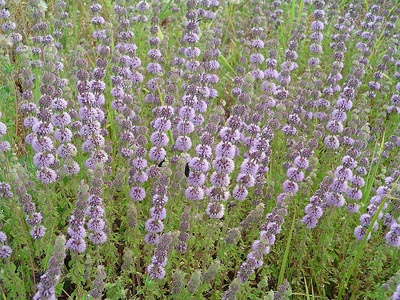
Pacific Northwest Medicinal Plant Guide (Check out all plants growing in Tryon Farm's medicinal garden!)
- Login to post comments



Pear, Asian (Pyrus spp.) Non-Native
Pear, Asian (Pyrus spp.)
Parts used: fruit
Nutritional information: an excellent source of water-soluble fibers, including pectin. They are also a good source of vitamin C, copper, vitamins B2 and E, and potassium (Murray 303).
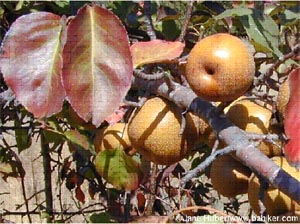
Pacific Northwest Medicinal Plant Guide (Check out all plants growing in Tryon Farm's medicinal garden!)
- Login to post comments



Parsley (Petroselinium crispum) Non-Native
Parsley (Petroselinium crispum)
Parts used: leaves, root, seeds
Medicinal uses: Fresh leaves are highly nutritious; seeds have a stronger diuretic effect than the leaves, can be used in the treatment of gout, rheumatism, and arthritis; the root can be used for flatulence, cystitis, and rheumatic conditions; parsley can promote menstruation both in stimulating a delayed period and in relieving menstrual pain (Chevallier 245).
Nutritional information: Parsley is extremely rich in a large number of nutrients, chlorophyll, and carotenes. It is a very good source of vitamin C, folic acid, and iron. It is also a good source of minerals, including magnesium, calcium, potassium, and zinc as well as a good source of dietary fiber (Murray 220).
Additional uses: Infusions of parsley leaves and stems are said to be soothing and cleansing when added to bathwater. The oil is used in a variety of skin care products (Kowalchik 408).
Cautions: Excessive doses of seeds are toxic. Do not take the seeds during pregnancy or if suffering from kidney disease. Parsley is best avoided for nursing mothers as it can dry up the milk supply (Chevallier 245).
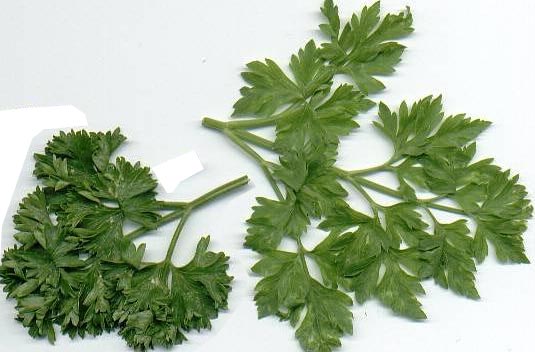
Pacific Northwest Medicinal Plant Guide (Check out all plants growing in Tryon Farm's medicinal garden!)
- Login to post comments



Oregon Grape (Mahonia aquifolium) Native
Oregon Grape (Mahonia aquifolium)
Parts used: root (young leaves as well)
Medicinal uses: Chiefly used for gastritis and general digestive weakness, to stimulate gallbladder function, and to reduce congestion (mainly of the gut). It also treats eczema, psoriasis, acne, boils, and herpes, and skin conditions linked to poor gallbladder function (Chevallier 177).Contains many of the same constituents as Goldenseal and can often be used in blends to replace this endangered herb
Additional uses: Yellow and tan dyes can be obtained from the roots and from the stems and leaves combined. The fruit yields a purplish blue color to wool mordanted with alum (Kowalchik 405).
Cautions: Avoid use during pregnancy (Chevallier 177).
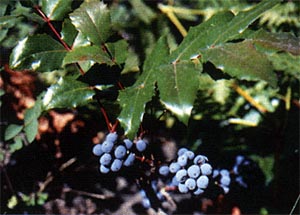
Pacific Northwest Medicinal Plant Guide (Check out all plants growing in Tryon Farm's medicinal garden!)
- Login to post comments



Oregano (Origanum vulgare) Non-Native
Oregano (Origanum vulgare)
Parts used: aerial parts, essential oil
Medicinal uses: Helps to settle flatulence and stimulates the flow of bile; strongly antiseptic, it may be taken to treat respiratory conditions such as coughs, tonsillitis, bronchitis, and asthma; also considered to be a useful promoter of menstruation; the diluted oil can be applied to toothache or painful joints (Chevallier 242).
Additional uses: This plant is well known for its culinary uses. Flowers of oregano can be used in flower and herb arrangements (Kowalchik 403).
Cautions: Do not take medicinal does during pregnancy. External use may cause irritation to the skin. Do not take the essential oil internally (Chevallier 242).
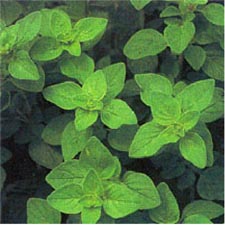
Pacific Northwest Medicinal Plant Guide (Check out all plants growing in Tryon Farm's medicinal garden!)
- Login to post comments



Olive (Olea europaea) Non-Native
Olive (Olea europaea)
Parts used: leaves, oil
Medicinal uses: The leaves lower blood pressure and help to improve the function of the circulatory system. The leaves are also mildly diuretic and may be used to treat conditions such as cystitis. There is also some research showing olive leaf’s ability to lower blood sugar levels and therefore being taken by some for diabetes. The oil is nourishing and improves the balance of fats within the blood. Traditionally olive oil has been taken with lemon juice to treat gallstones. The oil has a generally protective action on the digestive tract and is useful for dry skin.
Nutritional information: Olives and their oil are an excellent source of oleic acid, an omega-9 monounsaturated fat. They are also a good source of vitamin E. they also contain flavonoids (Murray 435).
Cautions: None known (Chevallier 241).
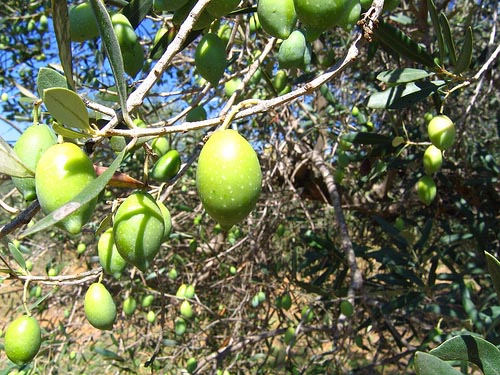
Pacific Northwest Medicinal Plant Guide (Check out all plants growing in Tryon Farm's medicinal garden!)
- Login to post comments



Feedback and participation welcome! Please send bug reports to web@tryonfarm.org







